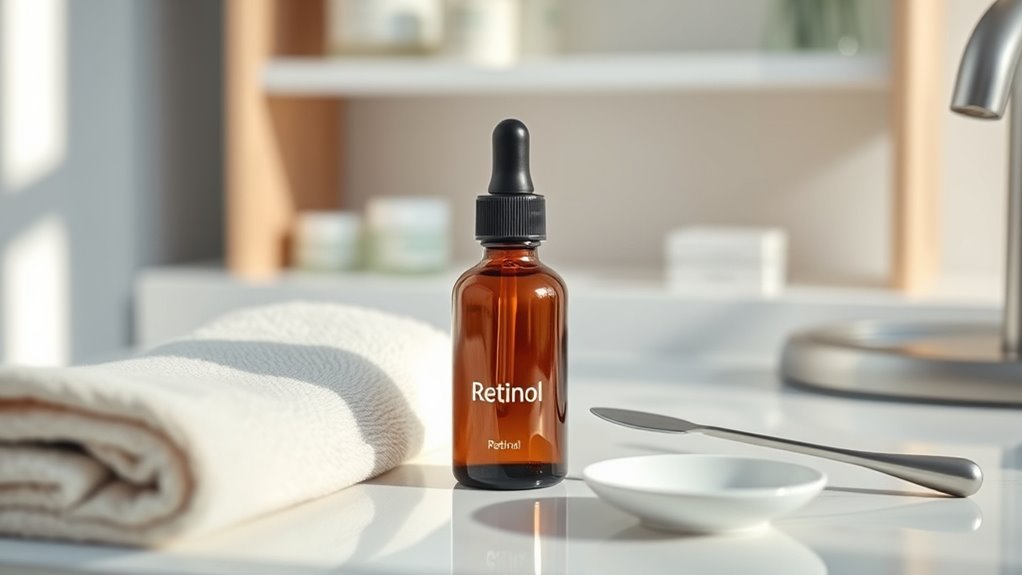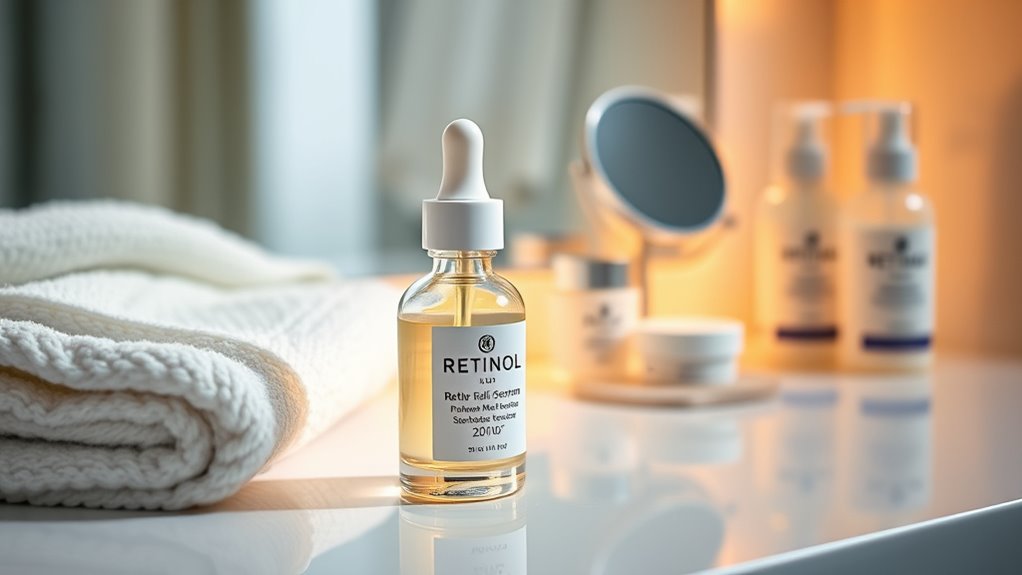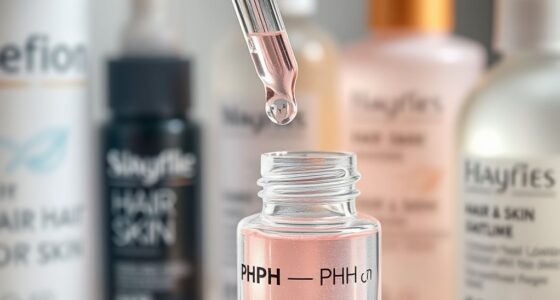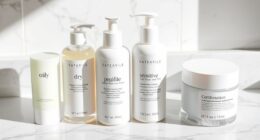To safely incorporate retinol into your skincare routine, start with a low concentration like 0.25% or 0.5% and use it just 1-2 nights a week. Gradually increase frequency as your skin adapts, always applying on clean, dry skin and following with moisturizer. Don’t forget to apply sunscreen daily, as retinol increases sun sensitivity. For more tips on building your routine confidently, continue exploring effective strategies.
Key Takeaways
- Start with low retinol concentrations (0.25% or 0.5%) to build skin tolerance gradually.
- Incorporate retinol gradually, beginning 1-2 nights per week, and increase frequency based on skin response.
- Apply retinol on clean, dry skin after washing, using a pea-sized amount, and follow with moisturizer.
- Always wear sunscreen during the day to protect skin from increased UV sensitivity caused by retinol.
- Monitor your skin regularly; reduce concentration or frequency if irritation occurs, and adjust routine accordingly.

Incorporating retinol into your skincare routine can substantially improve your skin’s texture and appearance, but doing so thoughtfully is key to avoiding irritation. One of the most important factors to consider is your retinol concentration. Starting with a lower concentration, such as 0.25% or 0.5%, allows your skin to build tolerance without overwhelming it. If you’re new to retinol, jumping straight into a high-strength product can cause redness, peeling, or dryness. As your skin adjusts, you can gradually increase the concentration, but always prioritize how your skin responds. Remember, patience is essential—high concentrations aren’t necessary for results and can increase the risk of adverse effects.
Application frequency is equally critical. When you first introduce retinol, begin by applying it once or twice a week at night. This limited exposure helps your skin adapt and reduces the likelihood of irritation. After a couple of weeks, if your skin tolerates it well, you can slowly increase the frequency to every other night. Some experienced users may eventually use retinol nightly, but listen to your skin’s signals. If you notice excessive dryness, redness, or peeling, scale back your application frequency and give your skin more time to recover. Consistency is more impactful than frequency; applying retinol regularly, but at a manageable pace, yields better results over time. Additionally, understanding your skin’s specific needs can help tailor your routine more effectively for optimal results.
Start with 1-2 nights a week, then gradually increase as your skin adjusts for best results.
To maximize safety and effectiveness, always apply retinol on clean, dry skin. Wait a few minutes after washing your face to ensure your skin is fully dry before applying. Use a pea-sized amount and spread it evenly across your face, avoiding the delicate eye area. Follow up with a moisturizer to buffer the retinol and minimize dryness or irritation, especially when you’re just starting out. Sunscreen during the day is non-negotiable, as retinol can increase your skin’s sensitivity to UV rays.
Monitoring your skin’s response is vital. If you notice persistent irritation or discomfort, reduce the retinol concentration or application frequency. Over time, your skin will become more tolerant, allowing you to incorporate retinol more confidently into your routine. By paying close attention to your skin’s needs, starting with a gentle retinol product at low concentration, and adjusting your application frequency accordingly, you set yourself up for safe, effective skincare that reveals a healthier, more radiant complexion.
Frequently Asked Questions
Can I Use Retinol With Other Active Ingredients Safely?
Yes, you can use retinol with other active ingredients, but ingredient compatibility matters. Avoid layering retinol with incompatible ingredients like vitamin C or AHAs without proper layering techniques. To minimize irritation, apply retinol at night and wait a few minutes before adding other products. Always patch-test new combinations and introduce one ingredient at a time to see how your skin reacts, ensuring safe and effective use.
How Often Should I Apply Retinol When Starting Out?
Imagine your skin as a delicate garden needing gentle tending. As a beginner, start with retinol once or twice a week, gradually increasing based on how your skin responds. This retinol frequency helps prevent irritation and allows your skin to adapt smoothly. Always listen to your skin’s signals, and remember, patience is key in your beginner skincare journey. Over time, you can safely build up to more frequent use.
Is Retinol Safe During Pregnancy or Breastfeeding?
During pregnancy or breastfeeding, it’s best to avoid retinol because of potential risks. For pregnancy safety, retinol can harm your baby, so consult your doctor before using any retinoids. Breastfeeding considerations also recommend steering clear of retinol, as it can pass into breast milk. Always prioritize your health and opt for safer alternatives like vitamin C or hyaluronic acid during this time.
What Should I Do if I Experience Irritation?
If you experience irritation, think of your skin barrier as a fortress under siege — gentle care can help it recover. First, stop retinol temporarily, then apply soothing remedies like aloe vera or ceramide-rich moisturizers. Avoid harsh scrubs and use lukewarm water to cleanse. If irritation persists, consult a dermatologist. You’re restoring your skin’s strength, one calming step at a time, just like rebuilding a fortress slowly and carefully.
Can Retinol Be Used on Sensitive or Acne-Prone Skin?
Yes, you can use retinol on sensitive or acne-prone skin, but start slowly. Choose a gentle formula with a lower concentration to minimize skin sensitivity and avoid aggravating acne concerns. Always patch test first, and apply retinol every other night or less frequently at first. If irritation occurs, reduce usage or switch to a milder product. Consistent, cautious use helps improve your skin without unnecessary irritation.
Conclusion
Remember, starting retinol gradually and using sunscreen daily isn’t just about avoiding irritation—it’s about protecting your skin’s future. Yes, it might feel like a big step at first, but patience and consistency pay off. Don’t let fear hold you back from achieving healthier, brighter skin. With proper care, retinol becomes a powerful ally on your skincare journey, helping you look and feel your best at any age. Trust the process—you’ll thank yourself later.









